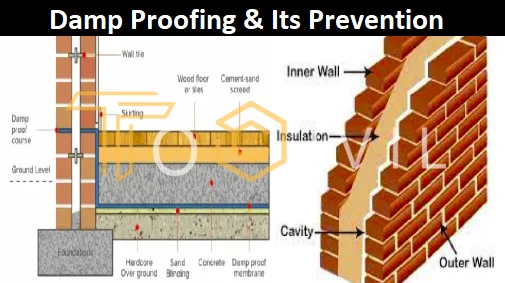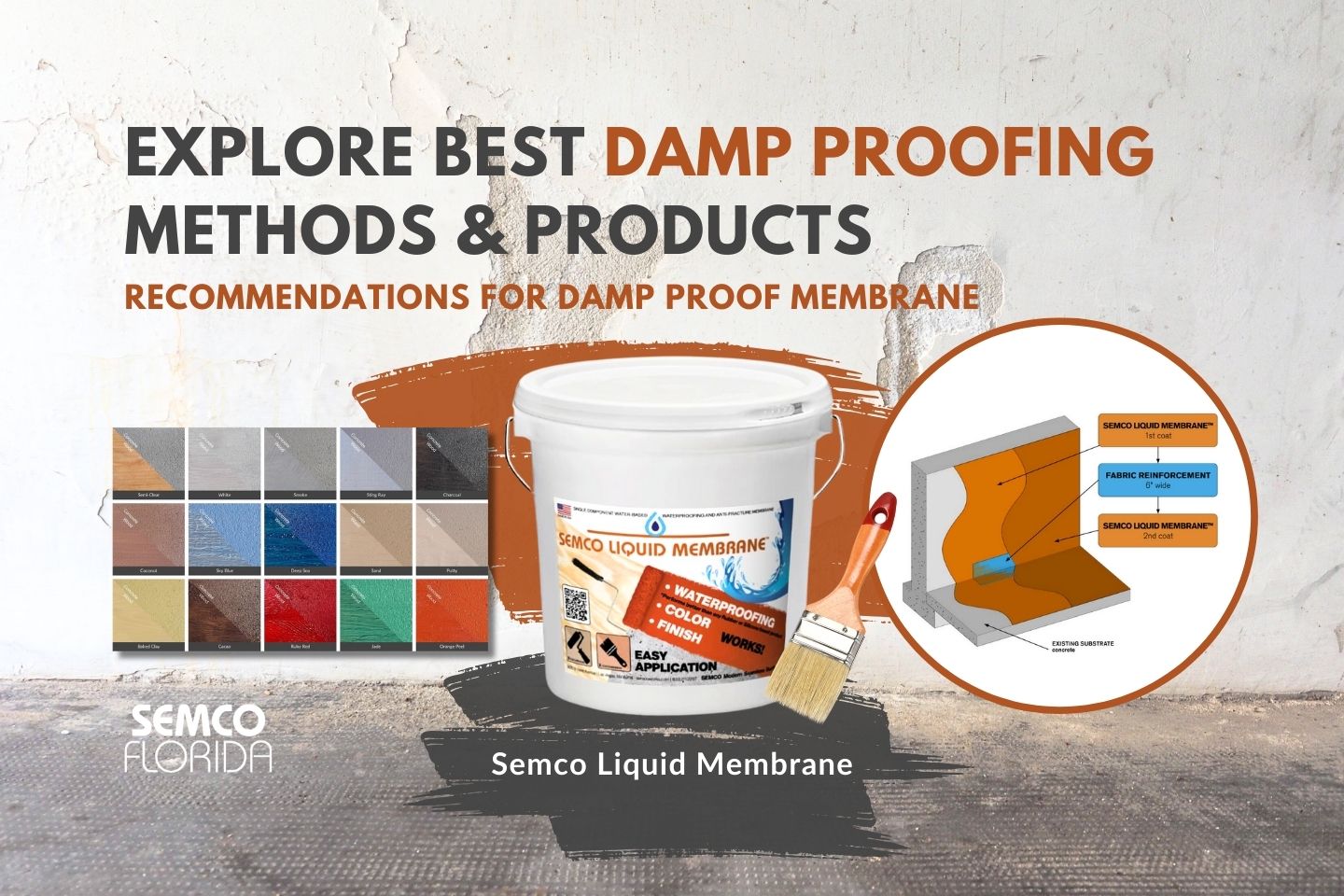Checking Out the Various Methods and Solutions for Effective Damp Proofing
Moisture in structures postures considerable challenges to both structural stability and indoor air high quality. Numerous methods and remedies have emerged to combat this pervasive issue. From standard damp-proof membranes to innovative chemical therapies, each method supplies one-of-a-kind benefits. Understanding these choices is essential for reliable wetness control. Nevertheless, picking the best option depends upon details structure conditions and requirements, triggering additional expedition right into one of the most reliable moist proofing approaches offered.
Comprehending the Reasons of Wetness
Dampness can develop from numerous resources, recognizing these causes is important for effective remediation. Generally, dampness stems from 3 key sources: rising moist, passing through damp, and condensation. Climbing wet occurs when groundwater takes a trip up-wards via porous products, such as block or rock, commonly because of a lack of a reliable barrier (damp removal newcastle). Permeating damp is commonly triggered by exterior aspects, consisting of roofing system leakages, defective gutters, or harmed wall surfaces, permitting water to infiltrate a property. Condensation, on the other hand, arises from excess moisture in the air, frequently aggravated by inadequate ventilation and temperature distinctions, leading to water droplets basing on surfaces. Recognizing these underlying concerns is important, as each kind of wetness calls for a customized approach for removal. Proper evaluation assists in establishing the most effective services, eventually protecting the architectural stability of a structure and boosting interior air top quality
Traditional Damp-Proof Membrane Layers

Chemical Damp-Proofing Solutions
Chemical damp-proofing remedies supply a cutting-edge approach to stop wetness intrusion in structures. These techniques typically include the application of liquid chemicals that pass through masonry and create an obstacle against rising damp. Commonly utilized chemicals include silanes, siloxanes, and various other water-repellent agents that respond with surface area products to produce a hydrophobic layer.The application procedure generally calls for exploration openings right into the wall surfaces, infusing the chemical service, and enabling it to cure. This approach is especially useful for older frameworks where traditional damp-proof membrane layers might be not practical. In addition, chemical damp-proofing can be less turbulent and much more cost-effective than extensive renovation projects.While efficient, these services depend upon appropriate application and ecological problems for peak efficiency. Normal maintenance and surveillance are vital to guarantee the durability of the damp-proofing treatment. Overall, chemical damp-proofing stands for a functional option for guarding buildings against moisture-related damage
Cavity Wall Surface Building And Construction Strategies
Tooth cavity wall building techniques offer numerous advantages, particularly in wetness control and power effectiveness. By integrating an air space in between 2 layers of masonry, these wall surfaces effectively minimize water ingress while improving insulation. This combination not just secures frameworks from moisture however likewise adds to decreased power consumption.
Benefits of Cavity Wall Surfaces
When considering effective moist proofing methods, the benefits of cavity wall surfaces stick out plainly. Tooth cavity walls contain 2 different layers, producing an air space that efficiently decreases moisture penetration. This style lessens the risk of moisture, as the outer wall surface works as an obstacle against rainfall and water ingress. Additionally, dental caries walls boost thermal insulation, which adds to energy effectiveness by lowering warmth loss. They also supply sound insulation, aiding to develop a quieter interior setting. Additionally, the air gap enables for ventilation, which aids in wetness control and reduces the probability of mold growth. These benefits not only improve the total comfort of a structure but additionally add to its long life and architectural stability.
Wetness Control Techniques
Efficient wetness control strategies are vital in dental caries wall construction to assure lasting protection versus dampness. One main technique includes the consolidation of weep holes, which help with water drainage from the cavity, avoiding accumulation. In addition, using breathable membranes can help manage wetness levels while permitting entraped vapor to escape. Correct positioning of insulation is likewise important, as it needs to not block drainage paths. Furthermore, making sure that the outer fallen leaves of the dental caries wall are built with waterproof products boosts total sturdiness. Regular upkeep checks are important to determine any type of obstructions or damages early, safeguarding the framework's stability. Inevitably, a mix of these strategies forms a durable defense versus dampness breach in dental caries walls.
Insulation and Energy Performance
Insulation plays an essential duty in boosting energy effectiveness within cavity wall building. By incorporating insulating materials, these walls develop a thermal barrier that reduces heat loss and reduces energy usage. Reliable insulation not just assists maintain a secure interior temperature level but likewise alleviates the danger of dampness, as it avoids condensation within the wall surface cavity. Various techniques, such as using rigid foam boards or mineral wool, can be employed to achieve suitable insulation efficiency. Additionally, appropriate installment is necessary to assure that spaces and gaps are decreased, which can otherwise compromise power efficiency. Eventually, a well-insulated tooth cavity wall surface adds significantly to general sustainability and lowers heating & cooling costs for property owners.
External Damp Proofing Methods
Exterior wet proofing approaches are necessary for securing structures from wetness infiltration. 2 reliable methods consist of the application of waterproof membrane layers and the installation of French drains pipes. These services aid alleviate water buildup and protect the integrity of buildings.
Waterproof Membrane Layer Application
While numerous methods exist for avoiding wetness ingress, the application of waterproof membranes stays a very efficient external wet proofing strategy. These membranes are commonly made from products such as polyethylene, rubber, or changed bitumen, supplying a robust obstacle versus water penetration. The setup process entails using the membrane to the exterior surfaces of wall surfaces or foundations, ensuring total protection to avoid leakages. Appropriate adhesion and securing at joints are essential to maximizing performance. Waterproof membranes can be applied in different types, including liquid coatings and sheet membrane layers, permitting for flexibility based on the details demands of the structure. This technique not only protects buildings from moisture however likewise improves their long life and structural integrity.
French Drain Installment
One efficient method for handling groundwater and avoiding moisture buildup around a structure's structure is the setup of a French drainpipe. This drainage system contains a trench full of crushed rock and a perforated pipeline that reroutes surface water away from the structure. Appropriate setup calls for mindful preparation, ensuring that the drainpipe inclines far from the structure to assist in suitable water circulation. Furthermore, the area of the drain is vital; it should be placed in locations vulnerable to merging or excess wetness. Regular upkeep, consisting of clearing debris from the crushed rock and making sure the pipe remains unobstructed, is important for long-lasting effectiveness. Inevitably, a well-installed French drain can considerably minimize the risk of water-related problems in basements and structures.
Inside Waterproofing Techniques
Interior waterproofing techniques are crucial for protecting a structure's inside from moisture infiltration and potential water damages. These strategies typically entail the application of customized materials and methods developed to develop a moisture barrier within the structure. One here usual technique is using waterproof coatings or sealants on wall surfaces and floors, which prevent moisture from penetrating surfaces.Additionally, mounting interior water drainage systems, such as sump pumps, can successfully take care of water accumulation in cellars and crawl areas. One more approach involves the usage of vapor obstacles, which are installed to inhibit dampness movement from the ground into living spaces.Moreover, addressing any kind of cracks or gaps in walls or foundations with appropriate sealers ensures a comprehensive protection against water intrusion. By carrying out these indoor waterproofing strategies, homeowner can significantly minimize the danger of mold development, architectural damage, and various other moisture-related issues. Appropriate implementation of these techniques is vital for long-lasting protection and building stability.
Normal Maintenance and Assessment Practices
Regular maintenance and inspection practices are essential for assuring the long-term efficiency of wet proofing options in any type of structure. Routine checks allow homeowner to determine early indicators of moisture intrusion, such as peeling off paint, mold development, and mildewy odors. These signs can signal underlying concerns that need immediate attention.Inspections need to be performed at least yearly, concentrating on at risk areas like cellars, crawl spaces, and outside wall surfaces. Throughout these evaluations, homeowner ought to examine sealants, drainage systems, and ventilation to validate they work correctly.Additionally, keeping seamless gutters and downspouts is important, as clogged up systems can cause water buildup near the structure. Applying a regular maintenance timetable, together with prompt repair services, can significantly prolong the life expectancy of damp proofing actions and secure the structural stability of the structure. Aggressive steps inevitably add to the total health and wellness of the living setting.
Often Asked Inquiries
For How Long Does Damp Proofing Typically Last?
The duration of moist proofing performance differs, commonly lasting in between 20 to half a century. Factors such as application quality, environmental problems, and upkeep techniques greatly affect the long life of the wet proofing therapy.

Can I Damp Evidence My Home Myself?
The specific pondered the usefulness of do it yourself damp proofing. With appropriate research study and the ideal products, it is possible. They additionally recognized the significance of expert advice to ensure lasting performance and stop future problems.
What Are the Indicators of Ineffective Damp Proofing?
Indications of ineffective damp proofing consist of relentless musty smells, visible mold and mildew growth, peeling paint, damp spots on wall surfaces, and timber decay - mould removal newcastle. Property owners need to deal with these issues immediately to stop additional damages and health issues
Does Damp Proofing Affect Indoor Air Quality?

How Much Does Specialist Damp Proofing Cost?
Specialist damp proofing prices vary substantially, normally varying from $1,000 to $5,000 depending upon the residential property's size, the extent of the moist concern, and selected approaches. Each situation needs a customized assessment for accurate pricing. Generally, dampness originates from 3 key resources: rising damp, permeating wet, and condensation. When taking into consideration effective moist proofing techniques, the benefits of tooth cavity walls stand out prominently. Outside wet proofing approaches are essential for safeguarding structures from wetness infiltration. While different techniques exist for protecting against dampness access, the application of water resistant membrane layers remains a highly reliable exterior moist proofing method. Indications of ineffective moist proofing include consistent mildewy smells, visible mold growth, peeling off paint, wet spots on wall surfaces, and wood decay.